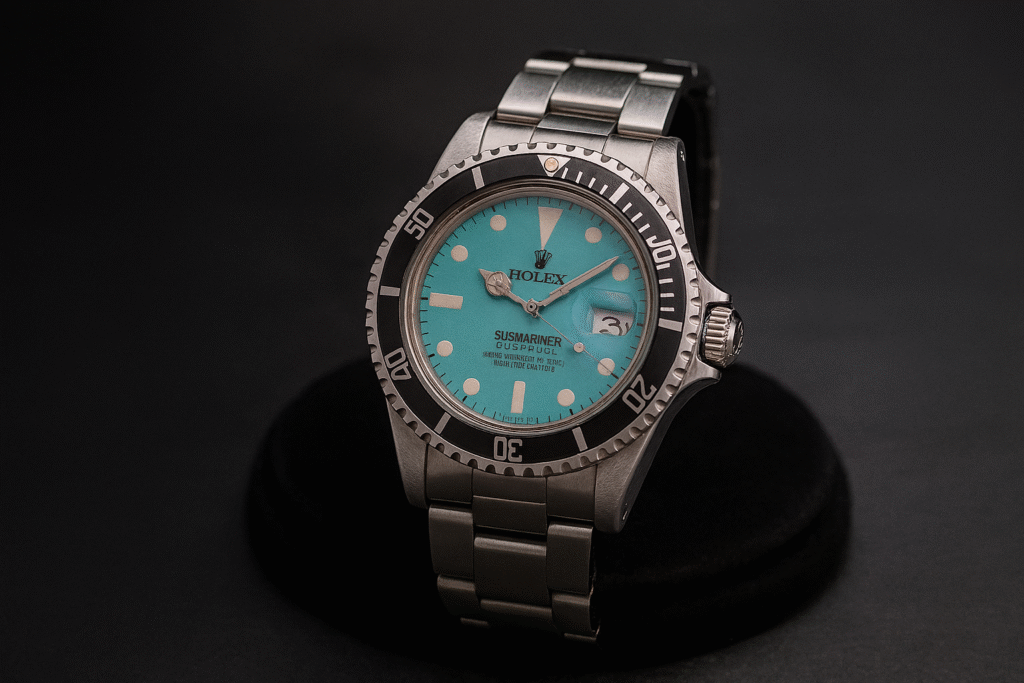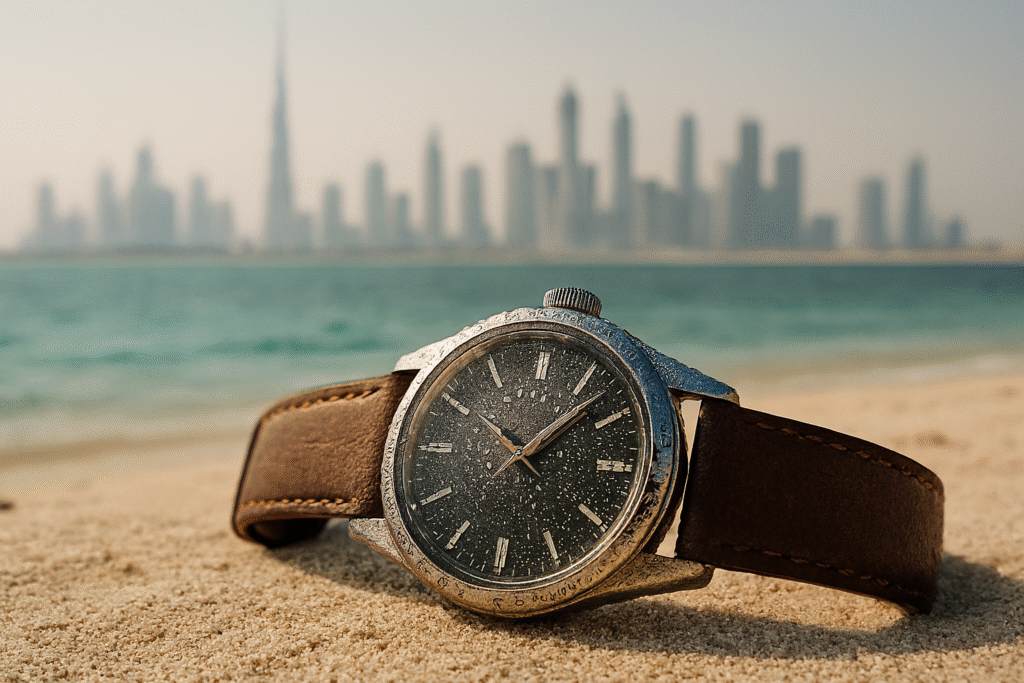In the late 1970s, a contestant on The Price is Right walked away with what looked like a simple door prize. Decades later, that very prize has resurfaced at Bob’s Watches — and it happens to be the Tiffany & Co. Rolex Submariner Ref. 1680. Known as one of the rarest vintage Rolex Submariners ever made, this piece combines Tiffany dual-signature branding, full provenance, and cultural significance.
The watch in question is a 1978 Rolex Submariner Ref. 1680, remembered as the first Submariner to include a date display. More importantly, this example stands out because of the Tiffany & Co. co-branding on the dial. Collectors value such dual-signed Rolexes for both rarity and cultural importance.
Why this Tiffany & Co. Submariner matters
- First Submariner model with a date window (Ref. 1680).
- Tiffany & Co. dual-signature, among the most desirable Rolex features.
- Provenance linked directly to a U.S. game show prize.
- Daily use by the original owner, adding authenticity to the story.
As Paul Altieri, CEO of Bob’s Watches, explained:
“It’s not just the rarity of the Tiffany dial, it’s the story. A game show prize became a cherished daily companion — and now, a world-class collector’s piece.”
Rolex collecting in numbers
Since 2010, Bob’s Watches has completed over 50,000 Rolex transactions. During the same period, Tiffany-signed Rolexes have increased in collector value by more than 35%. Furthermore, auction houses confirm record-breaking demand for dual-signed dials.
Q&A: Collectors want to know
Q: Why are Tiffany-signed Rolexes so valuable?
A: Dual-signed dials are rare because only a few retailers had this partnership. As a result, Tiffany-branded Rolexes enjoy even greater desirability.
Q: How can you authenticate a Tiffany Rolex?
A: Collectors should check correct serial ranges, dial printing consistency, and period-specific details. In addition, Bob’s Watches subjects each watch to strict authentication.
Q: What sets this Submariner apart from others?
A: Its unique story — a U.S. game show prize worn daily before entering the collector’s market. Consequently, it blends American pop culture with Rolex heritage.
Industry expertise and recognition
Bob’s Watches is widely known as the leading pre-owned Rolex marketplace in the United States. Through a transparent buy/sell model, rigorous authentication, and an educational approach, the company has built trust with new buyers and seasoned collectors alike.
Altieri added:
“We see ourselves as caretakers of history. Our responsibility is not only to authenticate and preserve but also to share the stories that make each Rolex unique.”
Suggested Reading:
If you’re interested in the history of Rolex co-branding, you can also explore the guide on Understanding Rolex Dial Variations.
For collectors focused on provenance, the article on How to Authenticate a Vintage Rolex provides a step-by-step approach.
And if you’re drawn to the cultural side, don’t miss the feature on Rolex Watches in American Pop Culture.
India Regional Cultures: A Complete Diversity Guide
India regional cultures are as diverse as its landscapes. This guide explores traditions, languages, and unique identities across the country. India Speaks FAQ on regional cultures reveals remarkable diversity across the subcontinent. Each state tells a unique story of tradition, heritage, and identity.
This India Speaks FAQ on regional cultures explores how geography, history, and local customs shape the cultural differences across India’s states and territories.
Understanding these regional differences helps you appreciate India’s true cultural richness.
What Makes India’s Regional Cultures Unique?
Each state develops its own distinct language, cuisine, and customs over centuries. Local history shapes traditions and daily life. Geography influences everything from clothing styles to building designs and lifestyle choices.
Examples of regional adaptation:
- Kashmir’s wooden homes with sloped roofs handle heavy snowfall
- Kerala’s houseboats work perfectly with extensive waterways and monsoon climate
- Rajasthan’s thick-walled buildings stay cool in desert heat
These regional adaptations show how different communities respond to their environment while keeping cultural identity.
How Do Regional Foods Reflect India’s Cultural Diversity?
Regional cuisine connects directly to local climate and crops. Coastal regions favor rice cultivation and seafood preparation. Northern states rely on wheat-based breads like roti, naan, and paratha.
Cooking methods vary significantly across regions:
- Mustard oil dominates Bengali cuisine
- Coconut oil is essential in Kerala cooking
- Ghee remains the preferred fat in Rajasthani dishes
When you travel across India, pay attention to these culinary differences. They reveal stories about the land, climate, and cultural preferences. India Speaks FAQ on regional cultures shows these food traditions matter.
Why Are Languages Central to Regional Identity in India?
India speaks through 22 official languages and hundreds of regional dialects. Each language carries unique cultural meaning. Language shapes traditional songs, folk tales, religious festivals, and social customs.
Language examples and their cultural significance:
- Tamil expresses the rich Dravidian heritage of South India
- Punjabi reflects Sikh traditions and agricultural lifestyle
- Bengali carries the literary legacy of Nobel laureate Rabindranath Tagore
- Hindi serves as a connecting language across northern states
Learning even a few local words helps you connect with regional communities. It shows respect for local culture.
What Role Do Festivals Play in India’s Regional Cultures?
Festivals serve as powerful expressions of regional identity. They bring communities together through shared traditions and celebrations. Each region celebrates differently based on local customs, crop cycles, and religious practices.
Regional festival examples:
- North India illuminates Diwali with millions of oil lamps and fireworks
- South India honors Pongal with harvest rituals celebrating farmers and nature
- West Bengal transforms during Durga Puja with art installations, classical music, and community feasting
Each festival reflects the unique cultural values and historical experiences of its region.
Which festival would you want to experience firsthand?
How Does Traditional Clothing Vary Across Indian Regions?
Climate conditions and available resources influence regional clothing styles across India. These variations demonstrate practical adaptation to different environments while maintaining aesthetic preferences.
Regional clothing examples:
- Rajasthan’s desert climate inspires bright turbans, flowing skirts, and mirror-work textiles that reflect heat
- Kerala’s humid tropical climate favors white cotton sarees with golden borders worn during festivals
- Nagaland’s mountainous terrain produces distinctive shawls featuring tribal symbols and geometric patterns
Each style represents clan identity and cultural heritage specific to its region.
How Do Regional Crafts and Arts Represent Cultural Identity?
Traditional crafts carry centuries of accumulated skill and cultural meaning. They serve as living expressions of regional identity. These art forms express creativity through traditions passed down through generations.
Regional craft examples:
- Bihar’s Madhubani paintings feature mythological themes and geometric patterns created by women during festivals
- Kerala’s Kathakali dance combines dramatic storytelling, classical music, and elaborate costumes
- Odisha’s traditional metalwork, particularly brass and bronze artifacts, carries deep ritual meaning in temple worship
Supporting these regional crafts helps preserve cultural heritage. It provides sustainable livelihoods for traditional artisans.
Why Should You Explore India’s Regional Cultures?
Exploring regional cultures offers experiences beyond visiting monuments and tourist attractions. You engage directly with daily life, authentic cuisine, and living languages.
Regional travel provides meaningful context rather than surface-level tourist highlights.
Benefits of regional cultural exploration:
- You connect with local communities on a personal level
- You taste authentic dishes prepared with traditional methods
- You hear regional languages and dialects in natural settings
- You witness festivals and ceremonies as they happen in daily life
Each regional visit deepens understanding of India’s diversity. It helps you appreciate how different communities adapt to their environments while keeping distinct cultural identities.
India Speaks FAQ on regional cultures demonstrates what makes the country culturally rich and endlessly fascinating for travelers and cultural enthusiasts.
Which region would you choose to explore first?



